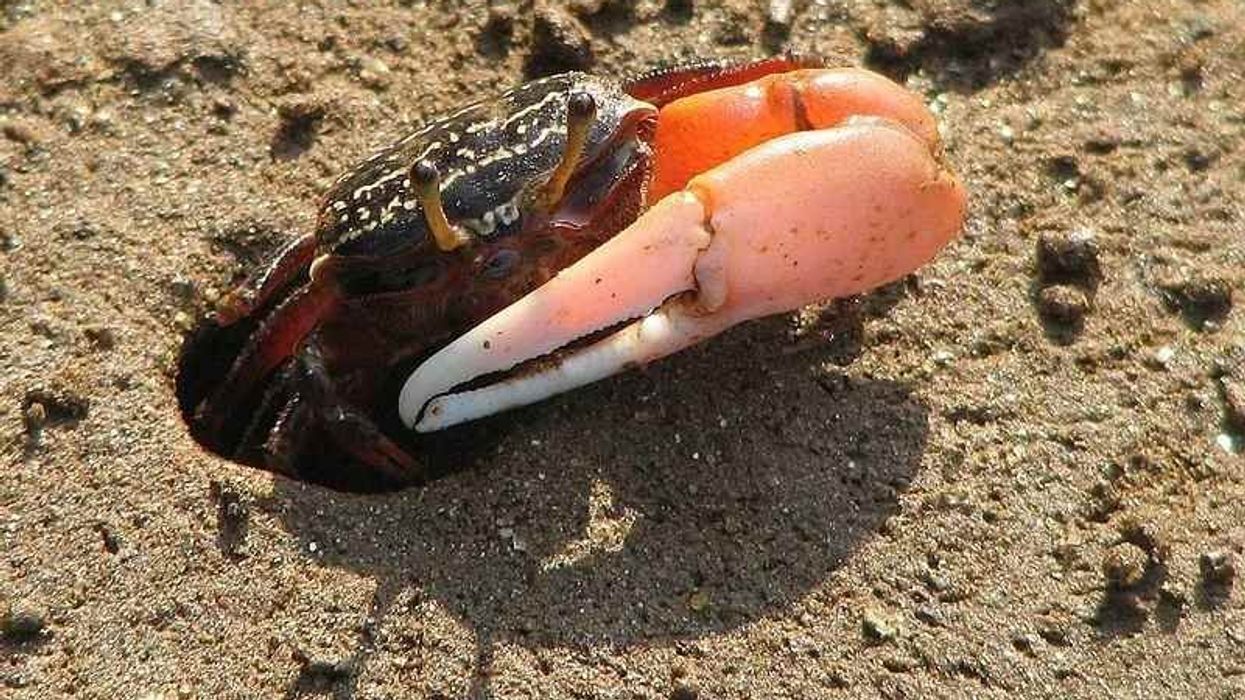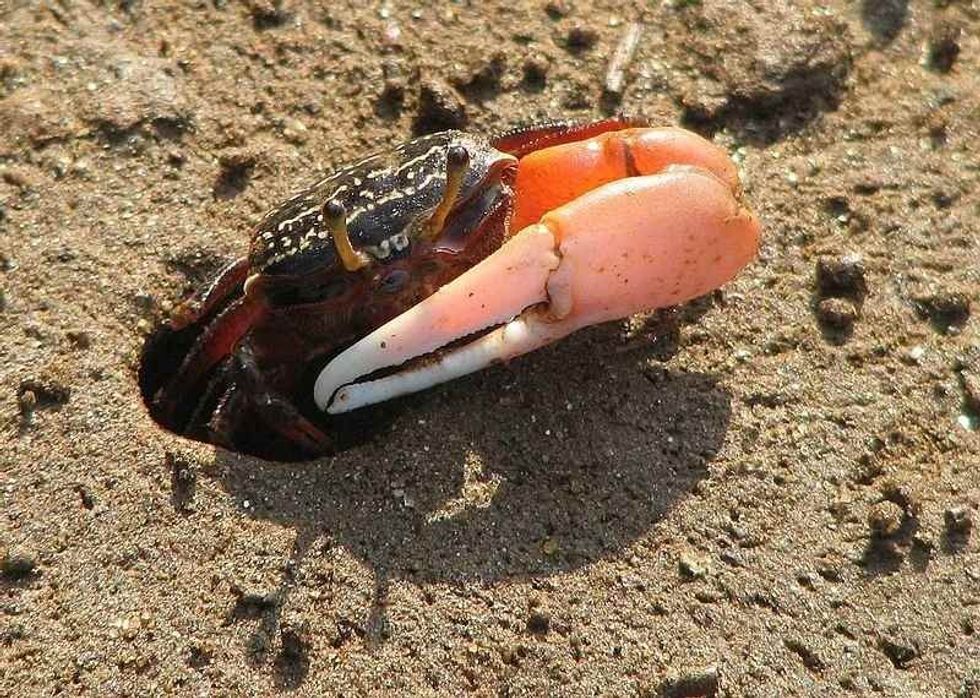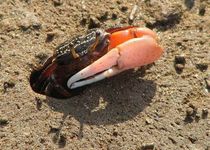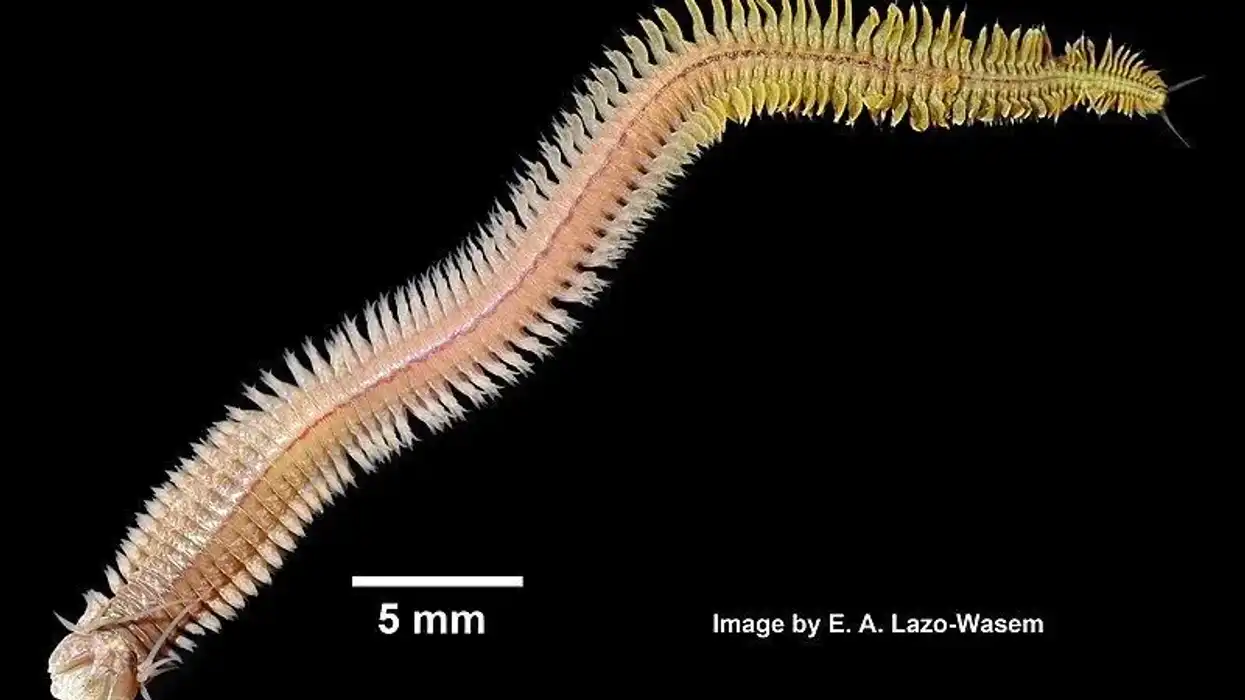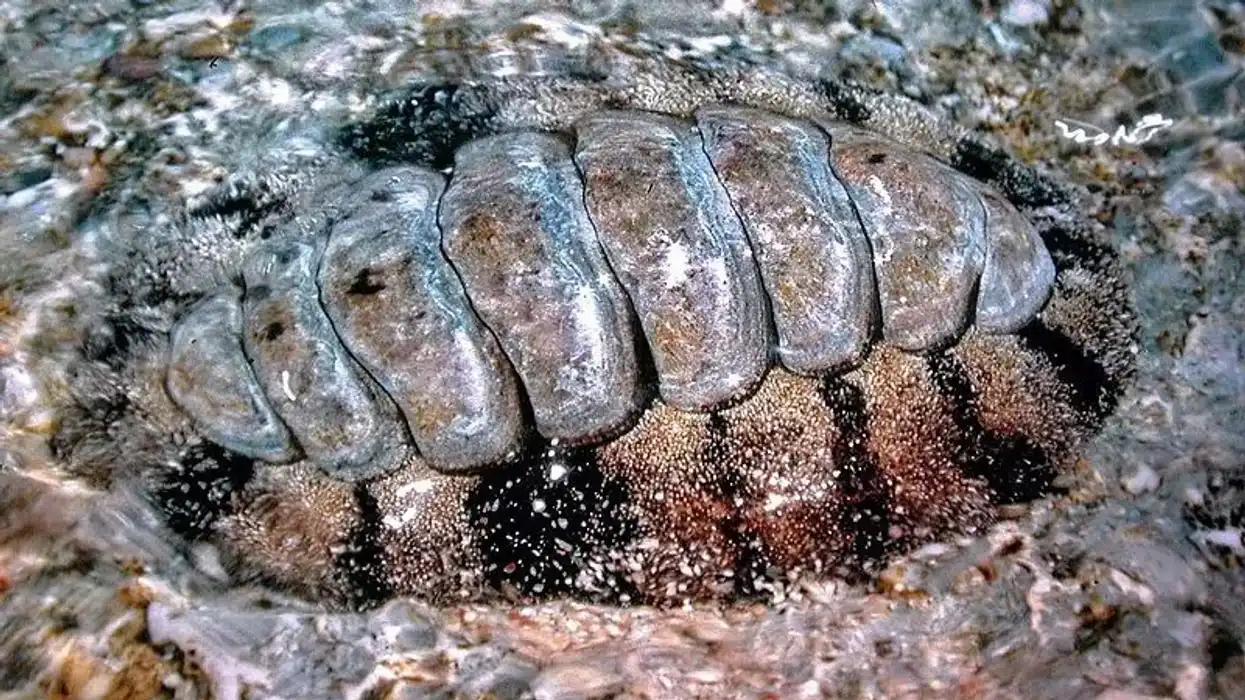Fun Fiddler Crab Facts For Kids

The fiddler crabs are members of the genus Uca and are synonymously known as calling crabs. There are numerous subspecies of fiddler crabs.
These fiddler crabs are famous for their one large claw or major claw, waving display, and circadian life cycle. This life cycle is entirely dependent on high tide. They have a wide geographical distribution range and these ranges differ for each fiddler crab species.
They can be found in mangroves, salty marshes, freshwater marshes, and sandy and muddy beaches, depending on the species. Many species of fiddlers can also be found on mudflats. Fiddler crabs have a short life span and can live for up to three years.
The mating season for fiddler crabs is mostly in the summer. In terms of territory and courtship over females, they are elusive and domineering. The fiddler crabs feed on food such as algae, detritus, bacteria, and rotten dead marshy plants.
They dig a 2 ft (61 cm) deep burrow to protect themselves from the high tide by covering the entrance of the burrow. These burrows are used for protection, incubation, and hibernation.
The female lays eggs in clutches in shallow holes like sand burrows of her male counterpart. The health of the male and female fiddler crabs is important for mating because it ensures that the newborn will hatch successfully.
If you enjoy reading this article, then do read and learn some surprising facts about other crabs, such as blue crab and green crab.
Fiddler Crab Interesting Facts
What type of animal is a fiddler crab?
The fiddler crabs' scientific name varies because they are from the genus Uca and all the species of fiddler crabs have their own scientific names, such as the red-jointed fiddler crab (Minuca minax) and the marsh fiddler crab (Minuca pugnax). These fiddler crabs are well known for their large claws, waving display and circadian life cycle, i.e.
high tide decides the activity of these crabs for the next day.
What class of animal does a fiddler crab belong to?
The fiddler crabs belong to the class of Malacostraca similar to the hermit crab and the family Ocypodidae. They are from the genus Uca and the order Decapoda.
How many fiddler crabs are there in the world?
The exact number of these species has not been counted and is unknown globally. They are not rare and are found almost all over the world.
Where does a fiddler crab live?
The different species of fiddler crabs can be found all over the world. They have a wide geographical distribution range. They are found in Massachusetts, Florida, Louisiana, Texas, Alabama, the Caribbean, Central America, the Gulf of Mexico, Brazil, Cuba, and Mississippi. The geographical range differs for each fiddler crab species.
The red-jointed fiddler crab, Minuca minax, is found in Florida, Massachusetts, and Louisiana.
The sand fiddler crab, Leptuca pugilator, is found in Florida, from Pensacola to Massachusetts.
The marsh fiddler crab, Minuca pugnax, is found on the northwestern shores of the Atlantic Ocean.
What is a fiddler crab's habitat?
The fiddler crab habitat is one that they even keep clean. They are mostly found in mangroves, salty marshes, freshwater marshes, sandy and muddy beaches, which differ from each fiddler species.
Many species of fiddlers also live on mudflats. The red-joint fiddler species is believed to live at low and high tides, whereas, the sand fiddler lives on brackish beaches because they mostly feed on organic matter particles from sediment.
They dig a deep burrow up to 2 ft (61 cm) to protect themselves from high tides by covering the entrance. These burrows are used for incubation, hibernation, and protection from predators.
Who do fiddler crabs live with?
The fiddler crabs are found in large groups in their habitat and separate themselves on their own. Mostly they are seen in pairs in the burrow holes.
How long does a fiddler crab live?
The fiddler crabs have a short life span and live up to three years of age. In some cases, it is evident that they survive for two years only. On average, the fiddler crab lifespan is of short duration.
How do they reproduce?
The fiddler crab breeding season is mostly during summer. The male fiddler crab species is very dominating when they have to mate with the female fiddler.
They are seen indulging in a fight with other males in order to lure the female fiddler by waving their one major claw. The female fiddlers get attracted to the male fiddlers by the size of their claws because the size of the sand burrow of male fiddlers has a strong influence on the incubation warmth.
The female lays eggs in clutches in shallow holes like sand burrows of her male counterpart. Health plays an important role in the mating of the male and female fiddler crabs because this assures that the newborn will be hatched successfully.
The eggs laid are carried by the female fiddlers underneath her body and incubated for about two weeks.
The newborn larvae are planktonic for an additional time period of two weeks. Few of the male fiddler crab species are seen showing off their dominancy while they are fighting with another male to mate with the female.
The lost claw is generally weaker than the previous one. This quality is less evident in other aquatic animals.
What is their conservation status?
These species of fiddler crabs are not rare aquatic animals and are found globally. They are the least threatened species of crabs. They are on the Least Concern list.
Fiddler Crab Fun Facts
What do fiddler crabs look like?
The fiddler crabs are of different colors and sizes. The color varies from black, brown, red, and white. The male fiddler crab species has larger claws in comparison to the female crab.
Fiddler crabs have a carapace-like shell which is a square shape with rounded edges. The sand fiddler crabs are lighter in weight in comparison to the red-jointed fiddler crabs and the marsh fiddler crabs. The red-jointed crabs' carapace has groves behind their eyes, whereas, the male marsh fiddler crabs have a blue spot in the middle of their carapace.
The male sand fiddler crab has a blue or purple carapace. The size of each fiddler crab's carapace differs and is less than 1.5 in (4 cm).
They have four pairs of legs. The male fiddler has one small claw and one major claw. The lost claw regrows but is not the same size as before.
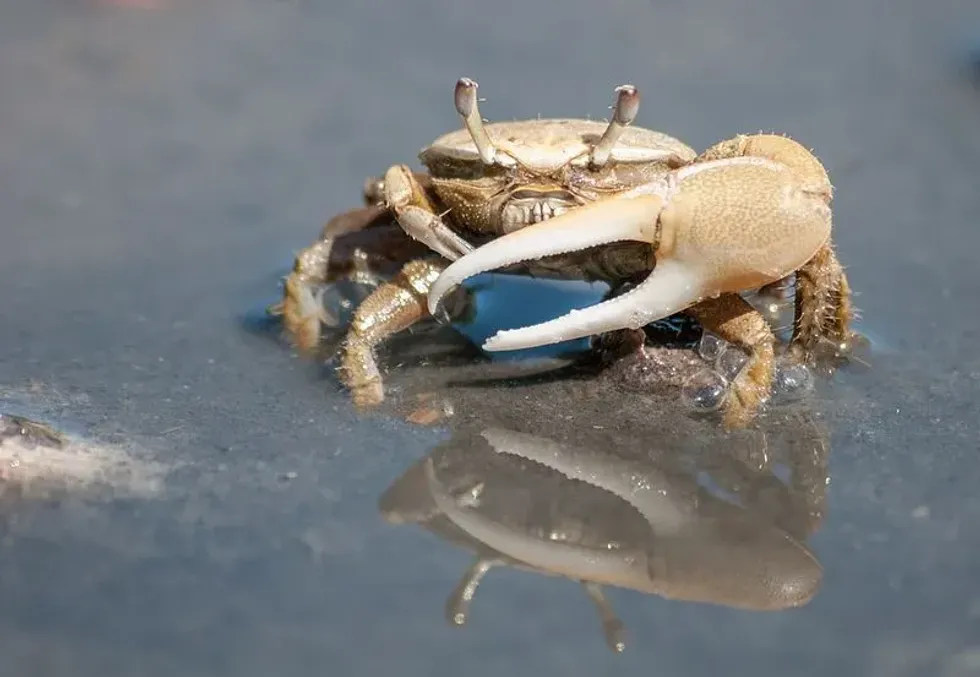
How cute are they?
They are cute, especially during the courtship. They move their large claws in such a way that they look like they are playing the violin. They are calm and can be considered cute because of their less aggressive behavior.
How do they communicate?
The fiddler crab communicates by certain usage of gestures and waves. The males use their big and large claws in competition with another male to lure the female. While they prey on their food, they make use of small claws to alert other species of their own kind.
How big is a fiddler crab?
The marsh fiddler crab is the smallest fiddler crab in the bay region and the red-jointed fiddler crab is the largest. They are 2-3 in (5-8 cm) long.
The red rock crab is bigger than these mud flats' crabs. The fiddler crab size depends upon different species. The size of their major claw and lost claw due to courtship fighting also contribute to their size drastically.
How much does a fiddler crab weigh?
The fiddler crab weighs up to 0.035-0.07 oz (1-2 g). The king crabs are more in weight.
What are the male and female names of the species?
There is no specific name for the male and female species.
What would you call a baby fiddler crab?
The female fiddler crab eggs hatch and move into open water. This larvae stage is called zoea.
What do they eat?
The diet food of the fiddler crabs consists of algae, detritus, bacteria, and rotten dead marshy plants. Many are seen on sand and sediments searching for organic matter particles they can feed on. The females generally have the privilege of eating first because of their small claws.
It becomes difficult for the male fiddler crab because of their large major claws. On basis of their food habit and diet, they are categorized as omnivores similar to the Dungeness crab. The Dungeness crabs food diet includes shrimps, mussels, and worms.
Are they aggressive?
No, they are not aggressive, but are territorial and dominating in courtship. They are considered among the calm crab species. They are often seen fighting with their major claws with other males of the same species. They can be even aggressive for the food they forge.
Would they make a good pet?
Yes, they would make a good pet and can be found in pet stores. They are rarely kept as pets because they feed on small fish.
They are brought in from their natural habitat, lagoons, and are most often called freshwater crab species because they are adapted to living in low saline water. The fiddler crab care must be the utmost priority if kept in a tank with proper diet and health and the fiddler crab tank size needs to be 10 gal (38 l).
Did you know...
The fiddle crabs are included by many people in their diet and many recipes are available on internet resources.
In Japan, they are known by the name siho maneki and in Brazil as chama mares.
In Peru, the movement of their one major claw gives them the name maestro sastres, which means 'good at sewing'.
These species are diurnal and sleep at night in their deep sand burrows near beaches, mudflats, and salt marshes to protect themselves from high tide.
The fiddler crabs are sexually dimorphic and the females can easily be identified from the males. The males have one larger claw and one small claw, whereas, the females have both claws of the same size.
These large claw crabs are known to shed their shell gradually as they get older.
The different species of fiddler crab are the blue fiddler crab, red fiddler crab, sand fiddler crab, mudflat fiddler crab, and long-fingered fiddler crab, among others. There are 100 fiddler crab species and they constitute 11 genera in the family Ocypodidae.
The feeding and burrowing of fiddler crabs contribute to the preservation of the natural environment. Because they live in salt marshes, they keep them clean, which indirectly aids in their growth. Their deep burrows contribute to the preservation of oxygen levels in marshy sediments.
Waving displays of courtship, eco-friendly animals, and circadian rhythm are some of the habits that distinguish them.
Naming the fiddler crab
The fiddler crab gets its name from one of their well-known fiddling behaviors by waving displays. When they move their claws, it appears that they are playing the violin. They are even called calling crabs.
Why do fiddler crabs have one big claw?
The fiddlers have one major claw for their own protection from other species, to mate and dig burrows. This one larger claw helps to show their dominance.
Here at Kidadl, we have carefully created lots of interesting family-friendly animal facts for everyone to discover! Learn more about some other anthropods from our Sally Lightfoot crab interesting facts or and slipper lobster fun facts for kids.
You can even occupy yourself at home by coloring in one of our free printable crab coloring pages.
We Want Your Photos!
More for You
Bachelor of Arts specializing in English, Bachelor of Education specializing in Secondary Education and Teaching, Master of Arts specializing in English

Anamika BalouriaBachelor of Arts specializing in English, Bachelor of Education specializing in Secondary Education and Teaching, Master of Arts specializing in English
Bachelor of Commerce specializing in Marketing and HR

Pradhanya RaoBachelor of Commerce specializing in Marketing and HR
With a Bachelor’s degree in Commerce from Christ University, Bangalore, Pradhanya's passion for the English language and literature led her to explore the field of content writing, where she has gained extensive experience in writing, reviewing, editing, and fact-checking. She has also earned certifications in Google Ads Search, Google Ads Display, and Social Media Marketing, showcasing her proficiency in digital marketing.
Disclaimer
1) Kidadl is independent and to make our service free to you the reader we are supported by advertising. We hope you love our recommendations for products and services! What we suggest is selected independently by the Kidadl team. If you purchase using the Buy Now button we may earn a small commission. This does not influence our choices. Prices are correct and items are available at the time the article was published but we cannot guarantee that on the time of reading. Please note that Kidadl is a participant in the Amazon Services LLC Associates Program, an affiliate advertising program designed to provide a means for sites to earn advertising fees by advertising and linking to Amazon. We also link to other websites, but are not responsible for their content.
2) At Kidadl, we strive to recommend the very best activities and events. We will always aim to give you accurate information at the date of publication - however, information does change, so it’s important you do your own research, double-check and make the decision that is right for your family. We recognise that not all activities and ideas are appropriate for all children and families or in all circumstances. Our recommended activities are based on age but these are a guide. We recommend that these ideas are used as inspiration, that ideas are undertaken with appropriate adult supervision, and that each adult uses their own discretion and knowledge of their children to consider the safety and suitability. Kidadl cannot accept liability for the execution of these ideas, and parental supervision is advised at all times, as safety is paramount. Anyone using the information provided by Kidadl does so at their own risk and we can not accept liability if things go wrong.
3) Because we are an educational resource, we have quotes and facts about a range of historical and modern figures. We do not endorse the actions of or rhetoric of all the people included in these collections, but we think they are important for growing minds to learn about under the guidance of parents or guardians.
